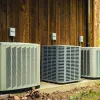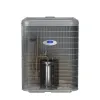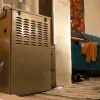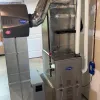Around here, it’s no secret that we love variable speed ACs and furnaces.
We extol them daily when customers ask about their best options for new HVAC systems. We’ve written about them on this blog a lot. We’ve compared variable speed AC systems to two-speed AC systems and discussed the differences between variable speed compressors and variable speed blowers.
But there’s one thing we haven’t discussed much when it comes to variable speed systems:
Some variable speed systems offer better performance than others.
True story. While virtually all variable speed systems will give you better performance and comfort than a standard, on/off HVAC system, there are certain variable speed systems that do an even better job than others.
They’re the ones that are paired with a communicating thermostat.
But wait. Before we get into that, let’s make sure we’re all on the same page about what variable speed heating and air conditioning systems are.
Variable speed systems ramp up and down to better match your heating and cooling needs.
Think about the furnace or heat pump you have today. If it’s a standard unit (and most are), it turns on when the indoor temperature dips below the thermostat setting. Then it turns off when it satisfies that thermostat setting.
So if you have the thermostat set to 70, the heat will come on when the temperature is 69 degrees. Then it will turn off again after bringing it up to 70.
That’s all fine and good, but what if instead of turning on and off, the system stayed on most of the time? It wouldn’t have to run at full blast; instead, it could run at a lower speed than you’re used to, maintaining your thermostat setting instead of waiting for the house to get cold before turning on.
Well, that’s what a variable speed system does. Instead of turning on and off all of the time, it runs at a very low speed most of the time. Then it ramps up its speed to match your heating or cooling needs when indoor temperatures fluctuate.
A system that operates this way has lots of advantages:
- More precise heating and cooling to match your needs
- Fewer issues with overly hot and cold areas in your home (i.e. more even, consistent temperatures)
- Better humidity control during the summer since the system runs consistently continues to dehumidify the air as it runs
- Less energy consumption; standard systems use a lot of energy to start up, but variable speed systems rarely have to start up after being turned all the way off.
- Quieter operation since the system mostly runs at lower speeds
Variable speed systems are just better. It’s that simple!
But the ones with communicating thermostats are even better.
Why a communicating thermostat makes your variable speed system even better
Assuming they’re installed properly, all variable speed systems offer the benefits discussed above. However, you’re not getting all of the advantages of variable speed if you don’t pair the system with a communicating thermostat.
Nowadays, major HVAC manufacturers also offer their own proprietary thermostats along with their variable speed systems. These thermostats are designed to give you even more control over indoor comfort and improve the operational efficiency of your system.
Take Carrier’s Infinity System, which includes the Infinity Wall Control communicating thermostat. From the panel, you can do much more than adjust the temperature! For example, you can:
- Set your desired relative humidity (RH) percentage so that the AC continues to reduce humidity even after satisfying your thermostat setting
- Have the system perform its own ductwork analysis, which lets you know if your static pressure is too high
- Set the system to automatically download software updates that improve efficiency and operation
- Control your system from your smartphone, so you can change your temperature and humidity settings even when you’re not at home; if you’ve ever left for vacation and forgotten to change the setting on your thermostat, you know how helpful this is!
Third party “smart” thermostats can do some of these things, but not all of them. You really benefit from using the system manufacturer’s own communicating thermostat.
Thinking about upgrading to variable speed? We think it’s always a good idea.
Variable speed systems offer better performance than standard units. Hands down.
The cost savings can also be significant, especially if you’re replacing a really old heating and air conditioning system. Since variable speed systems avoid the costly “on/off” style of operation that you get with a typical system, most homeowners save a lot on your energy bills in the long run.
At PV, we always install variable speed systems with the manufacturer’s communicating thermostat. Get in touch today to learn more or request an estimate for your home!






